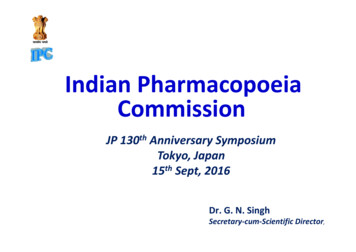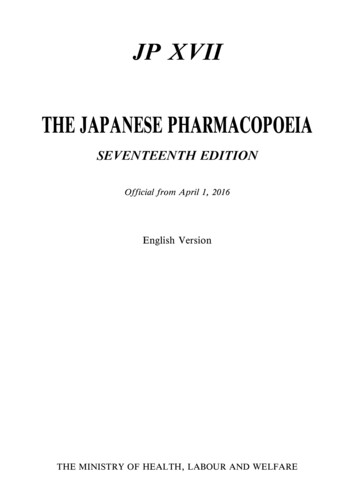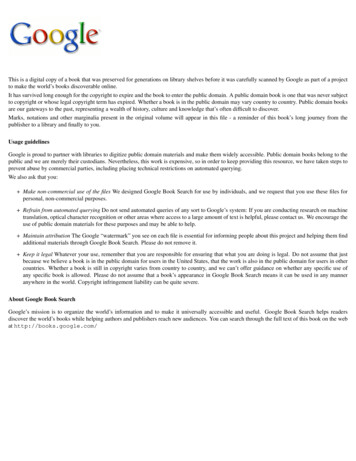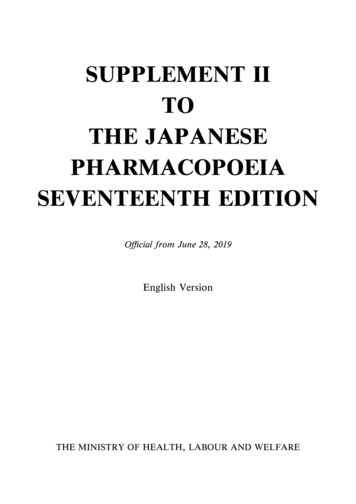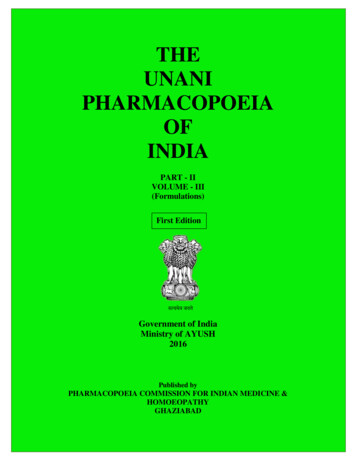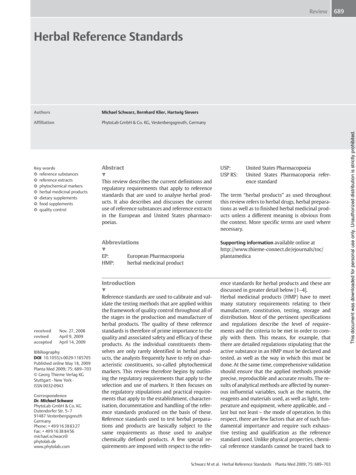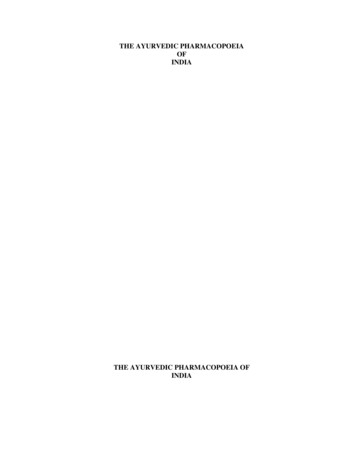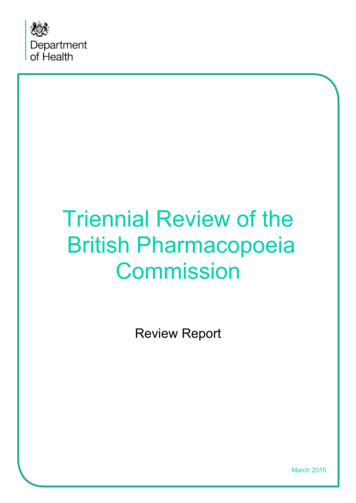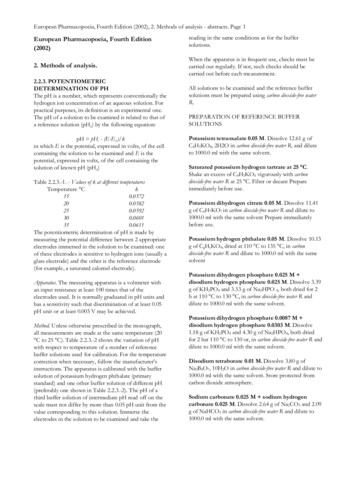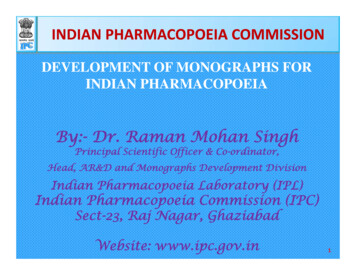
Transcription
INDIAN PHARMACOPOEIA COMMISSIONDEVELOPMENT OF MONOGRAPHS FORINDIAN PHARMACOPOEIABy::- Dr. Raman Mohan SinghByPrincipalP incipal Scientific OfficerOffice & CoCo-oordinator,ordinatordinato ,Head, AR&D and Monographs Development DivisionIndian Pharmacopoeia Laboratory (IPL)Indian Pharmacopoeia Commission (IPC)Sect--23, Raj Nagar, GhaziabadSectWebsite: www.ipc.gov.in1
INTRODUCTION In India, under the Drugs and Cosmetics Act 1940,the current edition of Indian Pharmacopoeia is abook of standards for drugs included therein andthe standards as included in the IndianPharmacopoeia would be official. Also, inAli severall otherth lawsloff India,I di theth IndianI diPharmacopoeia is recognised as the standard book. Indian Pharmacopoeia (IP) is published by theIndian PharmacopoeiapCommission ((IPC)) on behalfof the Ministry of Health & Family Welfare,2Government of India.
INTRODUCTIONContd. IP prescribes the standards for drugs producedand/or marketed in India and thus contributes inthe control and assurance of the quality of themedicines. The standards of Indian Pharmacopoeia areauthoritative and legally enforceable. It intends to help in the licensing of manufacturing,inspection and distribution of medicines.3
INTRODUCTIONContd. The Indian Pharmacopoeia is published incontinuing pursuit of the Mission of the IPC topromote public health in India by bringing outauthoritative and officiallyy acceptedpstandards forquality of drugs including active pharmaceuticalingredients, excipients and dosage forms, used byhealth professionals, patients and consumers. Publication of IP at regular and shorter intervals isone of the main mandates of the Commission.4
INTRODUCTIONContd.Contd Objectives of Indian Pharmacopoeia Commission isto develop comprehensive monographs for drugs tobe included in the Indian Pharmacopoeia, includingactive ppharmaceutical ingredients,gpharmaceuticalpaids and dosage forms as well as medical devices andto keep them updated by revision on a regular basis. To accord ppriorityy to monographsg p of drugsg includedin the National Essential Medicines List and theirdosage forms.5
INTRODUCTIONContd.Contd To collaborate with pharmacopoeias like the Ph.Eur., BP, USP, JP, ChP and InternationalPharmacopoeia with a view to harmonizing withgglobal standards. To organizeTieducationaldil programs andd researchhactivities for spreading and establishing awarenesson the need and scope of quality standards for drugsand related articles/materials.6
INTRODUCTIONContd.Contd IP monograph for an official substance orpreparation includes the articlearticle’ss definition,description, identification, packaging, storage,specifications,pimpurities,passayy and specificptests,one or more analytical procedures for each test,acceptance criteria and other requirements etc.Chemical structure, molecular formula alongwithIUPAC name of the substances also mentioned incase off chemicalh i l activeti pharmaceuticalhti l ingredient.idi t7
HISTORY OF IP The history of the IP began in the year 1833 when aCommittee of the East India CompanyCompany’ss Dispensaryrecommended the publication of a Pharmacopoeiaand Bengalg Pharmacopoeiapand General Conspectuspof Medicinal Plants were published in 1844, whichmainly listed most of the commonly used indigenousremedies. This was followed by IP 1868, which covered boththe drugs of British Pharmacopoeia (BP) 1867 andindigenousgdrugsg used in India,, with a Supplementpppublished in 1869 incorporating the vernacular8names of indigenous drugs and plants.
HISTORY OF IPContd.Contd However, from 1885 the BP was made official inIndia. A Drugs Enquiry Committee appointed in 1927 bythe government recommended the publication of aNational Pharmacopoeia. After independence,independence the Indian PharmacopoeiaCommittee was constituted in 1948 for publication ofIP as its main function,, which ppublished the IP in1955, followed by a Supplement in 1960.9
HISTORY OF IPContd.Contd This Pharmacopoeia contained both western andtraditional system drugs commonly used in Indiaand the same policy continued while preparing thePharmacopoeiapof India 1966 and its Supplementpp1975. There had been a phenomenal growth anddevelopment of the Indian Pharma industry sinceindependence, especially from early 1970, both in therangeg of Active Pharmaceutical Ingredientsg((APIs))and the dosage forms produced.10
HISTORYContd.Contd This totally transformed the profile of the IndianPharmaceuticals market and Indian Pharmaindustry emerged as one of the important globalsuppliersppof ppharmaceutical pproducts, both to thedeveloped and developing countries. These developments posed major challenges for theIP to reflect the quality standards of the marketeddrugs, which the subsequent editions of IP tried toaddress.11
HISTORYContd.Contd In view of these rapid advances, it was decided toppublish a new edition of the Pharmacopoeiapand itsAddenda at regular and shorter intervals for whichthe Indian Pharmacopoeia Committee wasreconstituted in 1978.1978 In the Pharmacopoeia of India 1985, its Addenda1989 and 1991, inclusion of traditional system ofdrugs was limited. However, most of the new drugs manufacturedand/or marketed were included, while only thoseherbal drugs which had definitive quality controlstandards had got place in it.12
ROLE OF CIPL IN IP WORK Central Indian Pharmacopoeia Laboratory wasestablished in the year 1965 under DirectorateGeneral of Health Services (DGHS), M/o H&FW assub-ordinate office/laboratoryy of CDSCO/DCG ((I).) Drugs Controller was the Member Secretary of IPCCommitteeitt andd DirectorDi t CIPL was theth memberb off IPCommittee. CIPL plays an active role is publication of IP-1985,IP-1996 and its subsequentqAddendum in 2000,, and2002, along with other regulatory and Zonal Testing13of Drug sample from North Zone of India.
DEVELOPMENT IN IP FOR 21ST CENTURY In view of the continuing rapid increase in therange of drugs produced in India, the IP 1996, itsAddendum 2000, Supplement 2000 for VeterinaryProducts and Addendum 2002 were published.p First time emphasis has given to veterinaryproducts also in veterinary supplement 2000 to IP1996. First time the monographsg pon Anti-RetroviralDrugs were introduced in the Addendum-2002.14
DEVELOPMENT IN IP FOR 21ST CENTURYContd. The IP Committee decided to delete the obsolete orless used product monographs and addedmonographs based on the therapeutic merit,medical need and extent of use of such articles inthe country.15
ROLE OF IPC IN FREQUENT PUBLICATION OF IP The Indian Pharmacopoeia Commission wasestablished in year 2005, dissolving the existing I.P.Committee and started working in existing CIPLwith its Director as Member Secretary.y The AddendumThAdd d2005 was publishedbli h d byb IPC which,hi hincluded a large number of antiretroviral drugs andraw plants commonly used in making medicinalproducts not covered by any other pharmacopoeias,which attracted much global attention.16
ROLE OF IPC IN FREQUENT PUBLICATION OF IPContd.Contd It provided systematic approach and practices forpublication of IP 2007 containing 271 newmonographs with focus on those drugs andformulations that cover the National Health CareProgrammes and the National Essential Medicines. Addendum 2008 to IP-2007 containing 72 newmonographs and amendments published in the year2008.17
ROLE OF IPC IN FREQUENT PUBLICATION OF IPContd. Ministry of Health and Family Welfare, Govt. ofIndia submerged the existing Central IndianPharmacopoeia Laboratory alongwith IndianPharmacopoeiapCommission ((IPC)) as a fullyyfinanced autonomous body from 1st Jan, 2009located at NCR region in Ghaziabad. It is a three-tier structure comprising of the GeneralBody of 25 members, Governing body of 13 membersand Scientific Body of 15-23 members from differentrelated scientific fields. Secretary-cum-Scientific Director of IPC is the18Member Secretary of all three bodies of IPC.
EXISTING BUILDING AT GHAZIABAD19INDIAN PHARMACOPOEIA COMMISSION, SEC‐23, RAJ NAGAR, GHAZIABAD
ROLE OF IPC IN FREQUENT PUBLICATION OF IPContd. The Secretary, Ministry of Health and FamilyWelfare, is the Chairman and the ChairmanChairmanScientific Body is the Co-Chairman of theCommission. The Secretary-cum-Scientific Director is the ChiefS i tifi andScientificd ExecutiveEti OfficerOffioff theth Commission.Ci i The IPC Secretariat and Indian PharmacopoeiaLaboratory (IPL) staff, with the support of differentadvisoryy expertspcommittee and expertpmembers ofthe Scientific body have examined the suitability of20the standards for the VIth edition IP-2010.
ROLE OF IPC IN FREQUENT PUBLICATION OF IPContd. IP 2010 contained monographs on antiretroviral,anticancer, antituberculosis and herbal drugs. Itfurther emphasized on biological monographs suchas Vaccines, Immunosera for human use, ical and non-biological) preparations. AddendumAddd2012 tot theth IP 2010 was publishedbli h d whichhi hhad taken care of the Amendments to IP 2010alongwith 52 new monographs.monographs21
PUBLICATION OF IP (BY IP ddendumIVthAddendumVet SupplementAddendumYear195519601966197519851989 & 1991199620002000200222
PUBLICATION OF IP (BY IP COMMISSION)EditionAddendumVthAdd dAddendumVIthAddendumVIIth (Current Edition)Addendum (Rec. Pub.)Year200520072008201020122014201523
PROCESS OF IP MONOGRAPHS DEVELOPMENTIndian Pharmacopoeia Commission (IPC)Scientific Body approves items for the IPIPC Scientific Staff liaisons and review itemsItems displayed on the website and mailedseparately for public reviewPublic comments receivedExpert Committee review comments andrespond in the Scientific Staff LiaisonsF thFurtherRevisionNeededIPC Scientific Staff liaison, compile andanalyse commentsFeedback fromSta keholddersComments andresponsesespo ses ddisplayedsp ayedon website/mailedNo further revision neededProposal accepted and publishedIndian Pharmacopoeia24
PUBLICATION OF IP ‐ 2014 Recently, the VIIth edition, IP- 2014 is published inaccordance with the principles and designed plandecided by the Scientific Body of the IPC. The standards prescribed in this edition areencouraged to adhere with the concept ofhharmonization,i tik ikeepingi viewinith technologicalthet h l i lstatus for manufacture and analysis of drugs andpharmaceuticalsinthecountrywithoutcompromising with the quality of the products. 577 new monographs were added in this VIIth25edition.
PUBLICATION OF IP – 2014Contd.Contd Number of monographs and appendices are expandedfurther to incorporate the latest technologicaladvancement and regulatory compliance. Constant efforts have been made to unify the NationalDrug Standards and to bring them in line with theInternational Standards pprogressivelygy byy addition ofmonographs of new drugs and adopting currentmethodology. IP-2014 was released on 4th Nov, 2013 by honourableMinister of Health & Familyy Welfare Shri GulamNabi Azad in a function at Nirman Bhawan, New26Delhi.
PUBLICATION OF IP – 2014Contd.IP-2014IP201427
SPECIFIC FEATURES OF IP‐IP‐2014 First time IP-2014 included with DVD-ROM. Out of 577 New Monographs, 134 API monographs,161 formulations monographs, 18 excipientmonographs, 43 NDS monographs, 10 antibioticmonographs, 19 anticancer monographs, 11 antiviralmonographsh are includedi l d d ini thisthi edition.diti Also 31 herbal monographs,monographs 05 monographs onvaccine & immunosera for human use, 06 monographson insulin pproducts and 07 monographsg ponbiotechnology products are included.28
SPECIFIC FEATURES OF IPIP‐‐2014Contd.Contd 19 new General Chapters and about 200 new IRspectraspectra’ss are also added. For the first time in IP, introducing 19 newRadiopharmaceutical Monographs with one GeneralChapter on Radiopharmaceutical preparations. This time separate volume of veterinary products isalso introduced for easy access.access 143 monographs on veterinary products along with16 appendices/General chapter on veterinaryproducts are also introduced.29
SPECIFIC FEATURES OF IP‐IP‐2014Contd. Now total number of IP Standards is reaching almost3000 which is almost at par with other internationalPharmacopoeias and comprising different categories ofdrugs and appendices as mentioned below: IP-2014 : Total Standards- General Monograph on Dosage Forms:37- Monographs on Drug Substances, Dosage forms andPharmaceutical Aids (A to Z) APIs:850 Formulations:1035 Excipients:128201330
SPECIFIC FEATURES OF IP‐IP‐2014Contd.- Monographs on Vaccines and Immunosera-for Human UseMonographs on Herbs and Herbal Productg p on Blood and Blood-relatedMonographsproductsMonographs on Biotechnology Products: 29: 11-Monographs on Radiopharmaceuticals: 19-: 63: 123245Monographg p on Veterinaryy eraSurgical:::::2085614050729031
SPECIFIC FEATURES OF IP‐IP‐2014Contd.Total MonographsAppendicesppTotal Standards:::2585 82 26671972782 82 2864 The Standards prescribed in the Indian Pharmacopoeiaare to establish the compliance with regulatoryrequirements on an article. The criteria to be adhered toare: (a) the interpretation of a monograph must be inaccordance with all the general requirements, testingmethods, texts and notices pertaining to it, in the IP and. (b) a product is not of standard quality unless itcomplies with all the requirements of the monograph. 32
GROWTH OF IP STANDARDS33
GROWTH OF IP STANDARDS34
GROWTH OF IP STANDARDS35
GROWTH OF IP STANDARDS36
GROWTH OF IP STANDARDS37
NEW CHAPTERS ADDED IN IP‐IP‐20142.2 Biological Methods2.2.17. DNA based Authentication techniquesq2.2.18.Transfusion and Infusion Assemblies & similarMedical Devices or Sterile Assemblies & medicalDevices2.2.19. Amino Acid Analysis2.3 Chemical Methods2.3.51. 2-Ethylhexanoic Acid2 3 52 Assay2.3.52.Aoff FFolicli AcidA id2.3.53. Ammonium2 3 54 Assay of Alpha tocopherol2.3.54.2.3.55. Fluorides38
NEW CHAPTERS ADDED IN IP‐IP‐2014Contd.2.4 Physical & Physicochemical Methods2.4.35.2 4 35 Bulk Density and Tapped Density of Powders2.4.36. Completeness of Solution2 4 37 Crystallinity2.4.37.C t lli it2.4.38. Specific Surface Area2.4.39. Mass Spectroscopy2.4.40. EthyleneyOxide and Dioxan2.4.41. Acetic Acid in Peptides2 4 42 Inductively Coupled Plasma - Mass2.4.42.Spectroscopy39
NEW CHAPTERS ADDED IN IP‐IP‐2014Contd.2.4.43. Characterisation of Crystalline and PartiallyCrystallineysolids byy X-rayy Power Diffraction2.4.44. Flash Point2.5 Pharmaceutical Methods2.5.11. Polymorphismyp40
ANTICANCER MONOGRAPHS IN bCarboplatinpCarboplatin InjectionDocetaxel AnhydrousGemicitabine HydrochlorideGemicitabine InjectionImatinib TabletsLapatinib DitosylateLapatinib TabletsMitomycinMiMitomycini InjectionI j iSorafenib Tosylate41
ANTICANCER MONOGRAPHS IN IP‐IP‐2014Contd.13.Sorafenib Tablets14.PremetrexedPtd DisodiumDi di15.Erlotinib Hydrochloride16.Erlotinib Tablets17.Fl d bi PhophateFludarabinePh h t18.Bicalutamide19.Bicalutamide Tablets42
ANTIVIRAL MONOGRAPHS IN amciclovir TabletsAciclovir CreamAciclovir Eye OintmentAciclovir Dispersible TabletsAciclovir Oral SuspensionAdefovir DipivoxilAdefovir tabletsSaquinavir CapsulesArbidol HydrochlorideT f i Fumarate,TenofovirFL i diLamivudineTablets&Ef iEfavirenz43
EXCIPIENT MONOGRAPHS IN me PotassiumAdipicp AcidAlfacyclodextrinAscorbyl PalmitateBetacyclodextrinCarboxymethylcellulose CalciumCorn OilCottonseed OilEthyl ParabenEthyl VanilinH dHydrogenateddVVegetablebl OilHydroxyethyl Cellulose44
EXCIPIENT MONOGRAPHS IP‐IP‐2014Contd.13.Hydroxypropyl Methylcellulose Phthalate14.14Isopropyl rubbing Alcohol15.Monobasic Sodium Phosphate16.Octyl Dodecanol17.Petrolatum18.Phenylethyl Alcohol19.Polacrillin Potassium20.Polyvinyl Acetate Phthalate21.P l i l AlcoholPolyvinylAl h l22.Soyabean Oil45
RADIOPHARMACEUTICAL MONOGRAPHS IN IP‐IP‐2014One General Chapter on Radiopharmaceuticals1.1(131I) Meta-IodobenzylMeta Iodobenzyl Guanidine Injection forDiagnostic Use.2.(131I) MMeta-IodobenzylGuanidineInjectiont I d blGidi I j ti forfTherapeutic Use.3.Fluorodeoxyglucose (18F) Injection4.Samarium (153Sm)) EthyleneyDiamineTetramethyleneyPhosphonate (EDTMP) Injection5.Sodium Fluoride (18F) Injection6.Sodium Iodide (131I) Capsules for Diagnostic Use46
RADIOPHARMACEUTICAL MONOGRAPHS IN IP‐IP‐2014Contd.7.Sodium Iodide (131I) Capsules for Therapeutic Use8.8Sodium Iodide (131I) Solution9.Sodium Pertechnetate (99mTc) Injection (Fission)10.99 Tc) Injection (Non-fission)Sodium Pertechnetate (99m11.Sodium Phosphate (32P) Injection12.Technetium (99mTc) DMSA Injection13.Technetium (99mTc) DTPA Injection14.Technetium (99mTc) EC Injection15.T h tiTechnetium(99mTc)T ) ECD IInjectionj ti16.Technetium (99mTc) Glucoheptonate Injection47
RADIOPHARMACEUTICAL MONOGRAPHS IN IP‐IP‐2014Contd.18.Technetium (99mTc) Mebrofenin Injection19.TechnetiumT h ti(99mTc)T ) MedronateM dt ComplexCl InjectionI j ti20.Technetium (99mTc) MIBI Injection48
IP ADDENDUM‐ADDENDUM‐2015 TO IP‐IP‐2014 This Addendum has the same authority as the IndianPharmacopoeiap2014. The General Notices, Monographs, Appendices andother contents of the Indian Pharmacopoeiapthat areamended by this Addendum supersede the originalmatter. This Addendum amends as well as adds newmaterials to the Indian Pharmacopoeia 2014. The General Notices and Appendices included in theIndian Pharmacopoeia 2014 apply to the contents ofthis Addendum as well unless specifically statedotherwise.49
IP ADDENDUM‐ADDENDUM‐2015 TO IP‐IP‐2014(CONTENTS) Notices Preface Structure of Indian Pharmacopoeia Commission Acknowledgements Introduction General Chapters Monographs on dosage forms, Monographs on drug substances, Monographs on Vaccines and Immunosera for human use, Monographs on Herbs and herbal products, Monographs on Radiopharmaceutical preparations andIndex.50
IP ADDENDUM‐ADDENDUM‐2015 TO IP‐IP‐2014(CHANGES) General chemical tests for identification of an articlehave been almost eliminated and the more specificinfrared and ultraviolet spectrophotometric tests havebeen given emphasis. The concept of relying onpublished infrared spectra as a basis for identificationhas been continued.continued The use of chromatographic methods has been greatlyextended to cope with the need for more specificity inassays and in particular, in assessing the nature andextent of impurities in ingredients and products. Most of existing Assays and Related substances testsare upgraded by liquid chromatographic method inview to harmonize with other internationalPharmacopoeias.51
IP ADDENDUM‐ADDENDUM‐2015 TO IP‐IP‐2014(GENERAL CHAPTERS) Keeping in view the essential requirement forharmonization of analyticalymethods with thoseadopted internationally, steps have been taken formonitoring the quality of drug. According we have revised general chapters onvolumetric glasses, peptide mapping, sterility testing,conductivity, solubility, dissolution test, bulk densityand tapped density of powders. For controlling the microbial quality of all themedicinal product general chapters on microbialcontaminationi ii non-sterileinil productsdandd test forfcolony forming units have been revised.52
IP ADDENDUM‐ADDENDUM‐2015 TO IP‐IP‐2014(NEW ADDITIONS)Monographs on Drug substances, Dosage forms &Pharmaceutical aids (A to Z)APIs:4357Formulations:8214Other MonographsHerbal Monographs: 13Vaccines & immunoseraimm nosera for humanh man usese: 02Radiopharmaceuticals Preparations: 102553
IP ADDENDUM‐ADDENDUM‐2015 TO IP‐IP‐2014(SPECIFIC FEATURES)Added:I.I57 new Chemical monographsII.13 new Herbal monographsIII.02 new Human Vaccines MonographsIVIV.10 Radiopharmaceutical MonographsV.06 Revised monographsVI.29 Revised testsVII.About 20 new IR spectras54
IP ADDENDUM‐ADDENDUM‐2015 TO IP‐IP‐2014(CHEMICAL MONOGRAPHS‐MONOGRAPHS‐ zole TabletsBarium Sulphate SuspensionBrimonidine Eye DropsBrimonidine TartrateBudesonide InhalationBudesonide Powder for InhalationCalcuim Pantothenate TabletsCiticoline Prolonged-release TabletsCiticoline InjectionCiticoline SodiumTabletsClemastine Oral Solution BitmapDorzolamide Eye dropsDorzolamide HydrochlorideEbastine Tablets55
IP ADDENDUM‐ADDENDUM‐2015 TO 25)26)27)28)29)30)Esclicarbazepine TabletsIfosfamideIfosfamide InjectionIloperidone TabletsIsotretinoin CapsulesKetotifen Fumarate TabletsLacidipineLacidipine TabletsLactulose Oral PowderMetformin Oral SolutionMethadone Oral SolutionMethylphenidate HCl Prolonged-release TabletsMethylphenidate HydrochlorideMetolazoneMetolazone TabletsMirtazapine56
IP ADDENDUM‐ADDENDUM‐2015 TO 41)42)43)Mirtazapine TabletsNabumetoneNabumetone TabletsRabeprazole InjectionRaloxifene Hydrochloride TabletsSitagliptin PhosphateSitagliptin TabletsTadalafilTadalafil TabletsTamsulosin Prolonged-release CapsulesTerazosin TabletsTolterodine TabletsTorsemide57
IP ADDENDUM‐ADDENDUM‐2015 TO 54)55))56)57)Torsemide TabletsVoriconazoleVoriconazole TabletsBrinzolamide Opthalmic SuspensionRanitidine Oral SolutionDorzolamide and Timolol Eye DropsEntacapone TabletsTiboloneTibolone TabletsS diSodiumNitNitriteitSodium Nitrite InjectionNetilmicin SulphatepInjectionjDutasteride CapsulesSterile Water for Inhalation58
IP ADDENDUM‐ADDENDUM‐2015 TO IP‐IP‐2014(HERBAL MONOGRAPHS‐MONOGRAPHS‐ ShankhpushpiDrakshaLodhraSahajana LeafSahajana stickGinsengGinseng Dry ExtractBassantBassant Dry ExtractAsthisamhrtaMirch59
IP ADDENDUM‐ADDENDUM‐2015 TO IP‐IP‐2014(HUMAN VACCINES MONOGRAPHS‐MONOGRAPHS‐ “02”)1.BCG for Immunotherapy2.2Influenza vaccine (Human,(Human live attenuated)60
IP ADDENDUM‐ADDENDUM‐2015 TO IP‐IP‐2014(REVISED MONOGRAPHS‐MONOGRAPHS‐ “06”)1.Gelatin2.2Dopamine Injection3.Dobutamine Injection4.Cisplatin55.Cisplatin Injection6.Barium Sulphate for Suspension61
IP ADDENDUM‐ADDENDUM‐2015 TO IP‐IP‐2014(PURCHASE OF INDIAN PHARMACOPOEIA)Addendum 2015 to IP-2014 can be procured from the officeof the Secretary-cum-ScientificyDirector, IP Commission atIPC Campus, Raj Nagar, Sector 23, Ghaziabad – 201 002(UP),India or from our distribution network (seewebsite:www.ipc.gov.in).biii )Other Distribution Centres:(1) M/s Educational BookCentre133, Gala Complex, Din Dayal Upadhyay Road,Mulund (W),Mumbai-400080.Phone :- 91-22-2560 3324 Fax:- 91-22- 25685341E-mail: ebc@vsnl.net62
IP ADDENDUM‐ADDENDUM‐2015 TO IP‐IP‐2014Contd.(2)(3)M/s Educational Book Agency (India),5-D , Kamla Nagar, New Delhi-110 007.Phone : 23844216, 41530228Fax: 011-23842077, Mobile:- 9811672690E Mail :E-Maileba@airtelmail ineba@airtelmail.in,ebaindia200@yahoo.co.inWeb: indianpharmacopoeia.inM/s Pharma Book Syndicate,4 3 375 Ansuya4-3-375,ABhBhawanO LOpp.Laneto CentralClBank, Bank Street, Hyderabad-500095.Phone:- 23445666, 23445622, 23445644,Phone:Fax:- 040- 23445611E-mail : info@ pharmabooksyndicate.com63
IP ADDENDUM‐ADDENDUM‐2015 TO IP‐IP‐2014(YOUR PARTICIPATION IN IPIP))Interested parties can participate in the following ways: Submit draft monographs along with supportingdocuments The Indian Pharmacopoeia encourages you to submitdraft monographs. Your draft may be the starting pointforo an oofficialc pubpublicc sstandard.d d.Propose Revisions to Existing General Chapters andMonographsg pYou can propose revisions to the general chapters andmonographs in the current official edition of the IndianPharmacopoeia.64
IP ADDENDUM‐ADDENDUM‐2015 TO IP‐IP‐2014(ROAD MAP FOR ADDENDUM‐ADDENDUM‐2016) Work Plan for Addendum- 20161.The monographs which were not taken in IP-2014 but was in thecompiled list considering monographs which are CDSCO approved,available in NLEM & Drug Today, received from Stakeholders etc.API’s whose formulations are missing and Formulations whose APImonographs are missing in IP-2014 and Addendum-2015.Up-gradation of existing monographs of IP-2014.Preparation of draft proposal for Amendments in response of the queriesreceived.Preparation of IR spectra’s, Structures, Nomenclature, category, Dose,Usual strengths,g , Solubilities,, reagentsg& Solutions etc of newmonographs.Verification of new monographs/ Revised tests whose sample/ Std’s areavailable.Up-gradation of General Chapters/ Appendices like Dissolution,Uniformity of Dosage Units etc.652.3.4.5.6.7.
IP ADDENDUM‐ADDENDUM‐2015 TO IP‐IP‐2014(ROAD MAP FOR ADDENDUM‐ADDENDUM‐2016)Working Time Schedule for the Addendum- 2015 Preparation of list of new monographs/revised tests - Upto Sept.Sept 2014 Acquisition/verification of new monographs- Dec. 2014 D f i off new monographsDraftingh- MarchM h 2015 Compilation of Amendments- April 2015 Comments from stakeholders and Preparation of manuscript- June 2015 Checking of manuscript & handover to printer- August 2015 Release of Addendum- Sep.Sep 2015 Implementation date of Addendum 2015- 1st Jan., 201666
DEVELOPMENT OF IP REFERENCE SUBSTANCES IPC provides the official Indian PharmacopoeiaReference Substances ((IPRS)) as pprimaryy referencestandards to the stakeholders. These are specifically requiredpharmacopoeialpptests and assays.y They are highly characterized substances selectedfor their critical attributes and suitability for theintendedpurposeasprescribedinthePharmacopoeia and are not necessarily suitable inother circumstances.67inmany
DEVELOPMENT OF IP REFERENCE SUBSTANCESContd. Biological Reference Substances, also abbreviated toIPRS and Standard Preparationspof antibiotics areissued by agencies authorised by the IPC. They are standardized against the InternationalSStandardsand ReferencefPreparationsiestablishedibythe World Health Organization (WHO).68
DEVELOPMENT OF IP REFERENCE SUBSTANCESContd. Indian Pharmacopoeia Laboratory is a modernanalyticalylaboratoryy capablepof doingg chemical andmicrobiological analysis, qualification testing ofcandidate reference materials and containerizationof such reference materials which become IndianPharmacopoeia official Reference Materials to beusedd ini conjunctionjtiwithith theth officialffi i l documentarydtstandards published in the Indian Pharmacopoeia. IPC is providing more than 350 IPRS includingimpuritiespand the list of available IPRS is updatedpon the website of IPC www.ipc.gov.in from time to69time.
DEVELOPMENT OF IP REFERENCE SUBSTANCESContd. Facilities for their storage and containerization is alreadydeveloped at IPL. Microbial reference cultures as per pharmacopoeialrequirements are very important for quality control inpharmaceutical industries. These cultures are required forestablishing acceptable performance of media, validatingmethods, verifying the suitability of test methods andassessing or evaluating performance in sterility testing,microbial bioassay and microbial limit test etc. IPC andCSIR-IMTECH, Chandigarh signed the MOU to provideauthenticated and certified microbial reference cultures atreasonable cost as per IP requirements.requirements The detail list ofavailable microbial cultures is also available on our70website.
DEVELOPMENT OF IP REFERENCE SUBSTANCESContd.71
ISO//IEC 17025:2005 NABL ACCREDITED LABORATORYISO Indian Pharmacopoeia Laboratory is accredited forboth chemical and biologicalgtestingg from Sept.2011pbyyNational Accreditation Board for testing andcalibration laboratories (NABL) of DST, New Delhif complyingforl i ISO/IEC 17025:17025 2005.2005 The IPL successfully reassessed for its secondextension for NABL accreditation this year andgranted the extension from 29 Sept., 2013 for the nexttwo years.72
ISO//IEC 17025:2005 NABL ACCREDITED LABORATORYISOContd. The IPL have different divisions for its differentactivities e.g.g AnalyticalyResearch & DevelopmentpDivision, Monographs Development Division,Reference Standards Development Division andQuality Assurance Division. IPL is well equipped with modern analyticalinstruments like HPLC, HPTLC, GC, GC-MS, GCHS, FTIR, TGA-DSC, LC-MSMS, ICP-MS, CHN-S,NMR, Polarimeter, Autotitrator, KF Titrator,Mi b lMicrobalancesetc.t73
ISO//IEC 17025:2005 NABL ACCREDITED LABORATORYISOContd.74
ISO//IEC 17025:2005 NABL ACCREDITED LABORATORYISOContd.75
ISO//IEC 17025:2005 NABL ACCREDITED LABORATORYISOContd.76
ISO//IEC 17025:2005 NABL ACCREDITED LABORATORYISOContd.77
ISO//IEC 17025:2005 NABL ACCREDITED LABORATORYISOContd.78
ISO//IEC 17025:2005 NABL ACCREDITED LABORATORYISOContd.79
ISO//IEC 17025:2005 NABL ACCREDITED LABORATORYISOContd.80
RESEARCH FACILITY AND TRAINING Analytical Research and Development Divisionppublished more than 50 Research ppapers/particles indifferent national and International journals on themethod development for drug and Pharmaceuticaland provided research facility and guided bysupervising for 05 Ph.D. and 30 P.G. students forth i researchtheirh projects.j t AR&D team has awarded for Best Research Papersin the field of Pharmaceutical Analysis for theirresearchh paper publishedbli h d ini IndianI diDDrugsi theinthyear 2013 by IDMA.81
RESEARCH FACILITY AND TRAININGContd. In IPL hundreds of students of pharmacy andanalyticalysciences alongg with several analystsy fromprivate and govt. sector provided training on themodern analytical instruments. IPC conducted two induction training programmelast year for 90 newly recruited Drug Inspectors inCDSCO with their collaboration at IPC,IPC Ghaziabad.GhaziabadAlso conducted a training programmeonRegulatorygy Aspectspfor State and Central DruggInspectors in this year.82
RESEARCH FACILITY AND TRAININGContd. Recently IPC conducted two training programmes inthis yyear for Govt. Drugg Analysty of different centraland state drug testing laboratories for hands-ontraining on various
publish a new edition of the Pharmacopoeia and its Addenda at regular and shorter intervals for which the Indian Pharmacopoeia Committee was reconstituted in 1978. In the Pharmacopoeia of India 1985, its Addenda 1989 and 1991, inclusion of traditional system of drugs was limited. However, most of the new drugs manufactured
